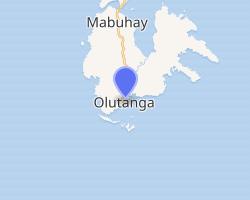Olutanga | |
|---|---|
| Municipality of Olutanga | |
 Map of Zamboanga Sibugay with Olutanga highlighted | |
OpenStreetMap  | |
Location within the Philippines | |
| Coordinates: 7°18′38″N 122°50′47″E / 7.31056°N 122.84639°E | |
| Country | |
| Region | Zamboanga Peninsula (Region IX) |
| Province | Zamboanga Sibugay |
| District | 1st District |
| Barangays | 19 (see Barangays) |
| Government | |
| • Type | Sangguniang Bayan |
| • Mayor | Arthur P. Ruste Sr. |
| • Vice Mayor | Janie Bert D. Gumba |
| • Representative | Wilter W. Palma II |
| • Electorate | 15,814 voters (2019) |
| Area | |
| • Total | 113.30 km2 (43.75 sq mi) |
| Elevation | 12 m (39 ft) |
| Population (2015 census) [3] | |
| • Total | 33,671 |
| • Density | 300/km2 (770/sq mi) |
| • Households | 6,523 |
| Economy | |
| • Income class | 4th municipal income class |
| • Poverty incidence | 49.37% (2015)[4] |
| • Revenue | ₱83,045,850.82 (2016) |
| Time zone | UTC+8 (PST) |
| ZIP code | 7041 |
| PSGC | |
| IDD : area code | +63 (0)62 |
| Climate type | tropical climate |
| Native languages | Subanon Cebuano Chavacano Tagalog |
| Website | www |
Olutanga, officially the Municipality of Olutanga (Cebuano: Lungsod sa Olutanga; Chavacano: Municipalidad de Olutanga; Tagalog: Bayan ng Olutanga), is a 4th class municipality in the province of Zamboanga Sibugay, Philippines. According to the 2015 census, it has a population of 33,671 people. [3]
The municipality is in the southwestern part of the eponymous Olutanga Island.
Barangays
Olutanga is subdivided into 19 barangays.
- Bateria
- Calais
- Esperanza
- Fama
- Galas
- Gandaan
- Kahayagan
- Looc Sapi
- Matim
- Noque
- Pulo Laum
- Pulo Mabao
- San Isidro
- San Jose
- Santa Maria
- Solar (Poblacion)
- Tambanan
- Villacorte
- Villagonzalo
Climate
| Climate data for Olutanga, Zamboanga Sibugay | |||||||||||||
|---|---|---|---|---|---|---|---|---|---|---|---|---|---|
| Month | Jan | Feb | Mar | Apr | May | Jun | Jul | Aug | Sep | Oct | Nov | Dec | Year |
| Average high °C (°F) | 31 (88) | 31 (88) | 31 (88) | 31 (88) | 30 (86) | 29 (84) | 29 (84) | 29 (84) | 29 (84) | 29 (84) | 30 (86) | 30 (86) | 30 (86) |
| Average low °C (°F) | 23 (73) | 23 (73) | 23 (73) | 24 (75) | 25 (77) | 25 (77) | 24 (75) | 24 (75) | 24 (75) | 24 (75) | 24 (75) | 23 (73) | 24 (75) |
| Average precipitation mm (inches) | 61 (2.4) | 55 (2.2) | 75 (3.0) | 81 (3.2) | 145 (5.7) | 189 (7.4) | 189 (7.4) | 197 (7.8) | 162 (6.4) | 181 (7.1) | 115 (4.5) | 70 (2.8) | 1,520 (59.9) |
| Average rainy days | 16.4 | 15.7 | 19.1 | 21.5 | 26.9 | 27.1 | 26.4 | 25.0 | 24.2 | 26.8 | 23.5 | 18.7 | 271.3 |
| Source: Meteoblue [5] | |||||||||||||
Demographics
| Year | Pop. | ±% p.a. |
|---|---|---|
| 1960 | 16,926 | — |
| 1970 | 16,991 | +0.04% |
| 1975 | 15,623 | −1.67% |
| 1980 | 14,539 | −1.43% |
| 1990 | 16,378 | +1.20% |
| 1995 | 17,069 | +0.78% |
| 2000 | 22,624 | +6.23% |
| 2007 | 27,521 | +2.74% |
| 2010 | 28,717 | +1.56% |
| 2015 | 33,671 | +3.08% |
| Source: Philippine Statistics Authority [3] [6] [7][8] | ||
Educational institutions
Tertiary
- Western Mindanao State University - External Studies Unit (WMSU)
High schools
- Loyola High School
- Olutanga National High School
- Pantaleon Cudiera National High School (Formerly Bateria NHS)
Elementary
- Olutanga Central Elementary School
- Bateria Elementary School
- Buhangin Mahaba Elementary School
- Esperanza Elementary School
- Fama Elementary School
- Gandaan Elementary School
- Kahayagan Elementary School
- Kalines Elementary School (Formerly Calais ES)
- Kauswagan Elementary School
- Matim Elementary School
- Pulo Laum Elementary school
- San Jose Elementary School
- Santa Maria Elementary School
- Tambanan Elementary School
- Villa Gonzalo Elementary School
- Villacorte Elementary School
Primary
- San Isidro Primary School
References
- ^ Municipality of Olutanga | (DILG)
- ^ "Province: Zamboanga Sibugay". PSGC Interactive. Quezon City, Philippines: Philippine Statistics Authority. Retrieved 12 November 2016.
- ^ a b c Census of Population (2015). "Region IX (Zamboanga Peninsula)". Total Population by Province, City, Municipality and Barangay. PSA. Retrieved 20 June 2016.
- ^ "PSA releases the 2015 Municipal and City Level Poverty Estimates". Quezon City, Philippines. Retrieved 12 October 2019.
- ^ "Olutanga: Average Temperatures and Rainfall". Meteoblue. Retrieved 1 May 2020.
- ^ Census of Population and Housing (2010). "Region IX (Zamboanga Peninsula)". Total Population by Province, City, Municipality and Barangay. NSO. Retrieved 29 June 2016.
- ^ Censuses of Population (1903–2007). "Region IX (Zamboanga Peninsula)". Table 1. Population Enumerated in Various Censuses by Province/Highly Urbanized City: 1903 to 2007. NSO.
- ^ "Province of Zamboanga Sibugay". Municipality Population Data. Local Water Utilities Administration Research Division. Retrieved 17 December 2016.
External links
.svg.gif)